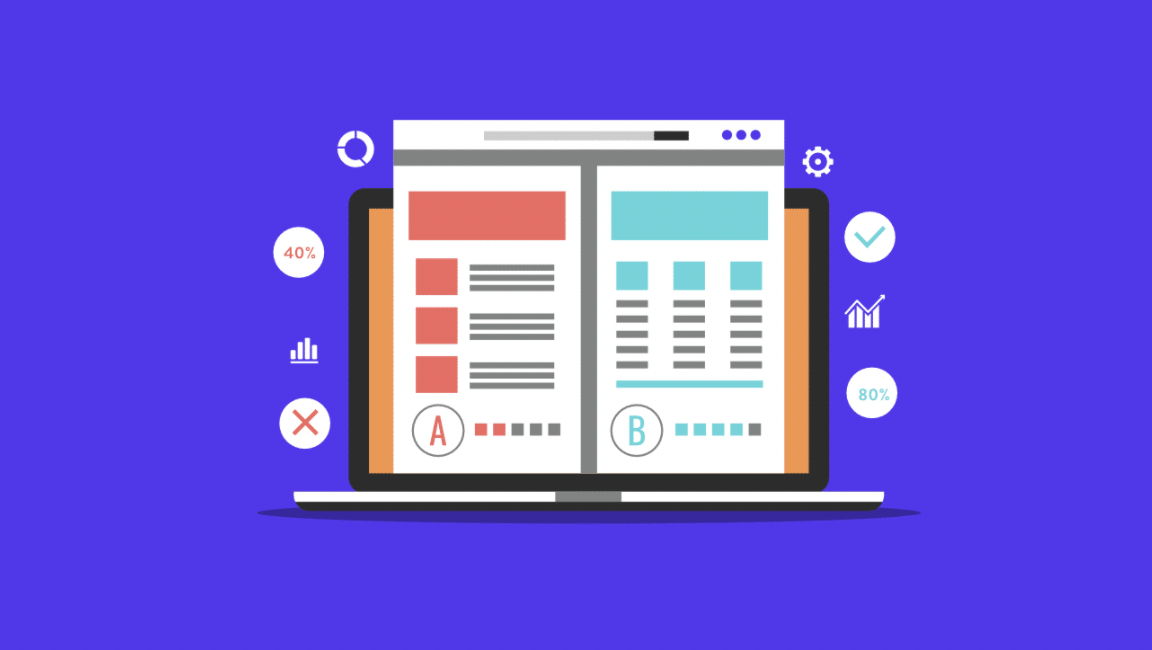Websites and the benefits of A/B Testing

AB testing (also known as split testing or multivariate testing) is a web design and development term that’s used to describe the testing of different elements on a website. It involves changing different website elements, where the impact of the different changes can be measured towards reaching a certain goal. AB testing is too often ignored or overlooked by designers and developers as a way to improve a websites’ design, and aid in its development. Whether its the landing page or checkout page, AB Testing can help optimise the whole customer journey from start to finish. When done right, AB testing is a very effective method of increasing the conversion rate on a website.
The most important thing to do when AB testing is to take your time. Come up with a hypothesis and analyse the results over a 7-14 day period. The reason for taking this amount of time is to determine the best method of data collection, which design version (A or B) looks best, and which version drives the most conversions.
Although it might sound like a little extra work for you to do on your website, the benefits of AB testing shouldn’t be underestimated.
AB Testing Measures Your Website’s Performance
The primary reasons for AB split testing are to aid the web design & development stages of your website in order to direct customers to where you want them to go as efficiently as possible. Whilst AB testing, you will be able to analyse key metrics which can help give you an overall view of your websites’ design and performance, versus how it could perform with any potential changes. When AB testing, you’ll be able to monitor different metrics that allow you to measure the overall performance of your website.
Basic Metrics
- Unique page views: measured by the number of page views from a single individual visitor during their session on the overall website.
- Page views: the number of times a single page has been viewed. This can be any page including, but not limited to, product pages, blog posts, contact pages etc.
- Location: refers to where your visitors are coming from, so you can create more targeted content or advertisements.
Engaging Metrics
- Average time on page: shows you how engaging the website design is by giving you the average time a visitor spends on a webpage
- Pages/Session: shows you how many pages a single user visits while they’re on the website.
- New vs returning: shows you how many new or returning visitors you have, giving you indication on whether your site is engaging enough to bring visitors back.
- Referral traffic: shows the number of websites that link and share content that’s on your site.
AB Testing Helps You Spot Problems on Your Site
Certain AB testing tools can show you which areas of your website design may be lacking or need improvement to boost overall sales. In addressing these areas, you have the ability to improve the website design greatly while increasing conversion rates. Upon AB testing your website design, you may find one or more of these areas lacking.
IMAGES
Unfortunately, many designers don’t use high quality images. This can really impact sales and the overall reputation of the business.
NAVIGATION
Website navigation can also be lacking depending on your layout and design. AB testing the navigation will enable you to see whether you can improve your visitors onsite experience. Website navigation should be easy to navigate without confusing your visitors. It should provide minimal click through pages and be clearly labelled so visitors know what they’re clicking into to find what they’re looking for.
CALLS TO ACTION (CTA)
Another area where many designers struggle. The idea of a call to action is to encourage people to connect through different portals and networks. Whether the conversion is a sale, subscription, or a download, you need to have an enticing and well-designed call to action to really connect and motivate visitors.
It Increases the Marketing Potential of Your Site
AB testing is the perfect way to hone and redefine your website design into a powerful and more profitable marketing tool. With careful analysis of the data collected from AB testing you can change key areas or elements of the design that can drive home the conversions you’re looking to achieve. The best ways to improve conversions is to leverage all you can from AB testing tools, and here are some ways you can achieve this.
TARGET METRICS
Before AB testing it’s a good idea to setup the target metrics you wish to achieve when you split test to determine the success of the test.
FEEDBACK
Try and ask your visitors for feedback through surveys and other forms. This will help you to decide on key areas of your website design that need addressing.
CHOOSE HIGH TRAFFIC PAGES
You should try to work on your high traffic pages first. High traffic pages are being seen by more people and tend to bring in more visitors. Generally landing pages are key pages which should be AB tested for better data collection and analysis. Split testing landing pages enables you to; convert more sales and revenue; lower your bounce rate; unveil any pitfalls that your landing page has; increase the conversion rate; eliminate guesswork and assumptions; gain better leverage over your competition.